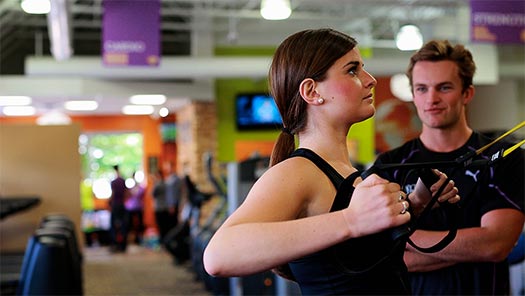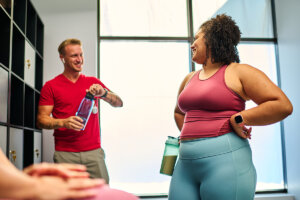Step aside, exercise bands and beloved balance balls! The TRX Suspension Trainer is here to stay—and for good reason, too. Now considered a mainstay at most gyms and health clubs across the country, the TRX suspension workout system was developed and utilized by the Navy SEALs. The TRX system is a form of suspension training that uses two things we all have readily available: gravity and body weight. This ergonomic approach will help strength train all your muscle groups and burn fat, while also working on your range of motion, flexibility, balance and core stability. The TRX Suspension workout system has plenty of options and is perfect for any level of exercise expertise, whether you’re at the front of the TRX movement or you’ve never tried it out.
TRX is one of the leanest suspension trainers out there, meaning it takes very little space and equipment to give you a full body workout. With just a durable piece of rope (okay, straps), a supporting beam and two foam handles that double as ankle straps, you can work tons of different muscle groups – you’ll be amazed at the workout your biceps, triceps, quad and butt get!
If you don’t think TRX is your thing, we recommend giving it a try. No matter what you think you know about TRX workout content, we guarantee you’ll find something you love! For example, did you know that many people practice TRX yoga? It’s true! Mixing TRX with yoga brings your yoga practice to a whole new level – literally! And if you think TRX yoga sounds way too complicated, don’t worry – the straps can actually help you balance and make the workout easier. If you don’t think you’ll like traditional TRX, check out a video or try a TRX yoga class with a friend!
How is TRX different from resistance bands or exercise bands? While exercise bands are a great part of any workout, TRX is a complete suspension training system. The positioning of the bands and handles provides tons of variability for your workout. While the TRX suspension training strap looks pretty simple, TRX bands can actually trick you into making some common mistakes and prevent you from getting the full benefit out of your TRX workout. Plus, if you use the TRX incorrectly, you may run the risk of injury—and we don’t want that. Even with your own body weight, you can still get hurt by performing movements incorrectly, which is why we’re here to help!
We’re about to break down the twelve most common TRX training mistakes that we see in the gym. You might not even know that you’re making these when you’re using TRX bands, as you can’t always feel the difference, so it’s important to be aware of them. If you’ve never tried a TRX workout, some of these tips might be unfamiliar to you, and that’s OK! When you feel ready, bring your questions to a personal trainer or check out workout guides or videos for incorporating TRX training into your workout routine. This full-body workout has resistance training benefits for your entire body – after reading these tips, try it today!
The Most Common TRX Mistakes
Thinking the TRX Will Do the Work for You
The TRX suspension trainer is only as effective as the person using it. Let us explain. Mental focus is key when you’re working out with the TRX suspension trainer. No matter your physical fitness level, you always should apply the “mind to muscle” principle to your TRX moves and think about each muscle group you’re engaging. Remember, you can make any exercise more or less challenging; all you have to do is change your body angle in your starting position.
Just like you can’t expect to lose weight and get in good shape without a healthy diet, healthy food and healthy exercise, you can’t expect the TRX Suspension workout system to magically make you stronger and burn fat. Work at your own pace, but make sure you’re pushing yourself with every rep. Remember, building muscle starts in your head!
Placing Your Feet in the Wrong Spot
Your feet and their starting position on the ground have the ability to make or break an exercise. Whether resting in the bottom of the foot cradles, or on the floor in standing position, it’s important to understand where your feet should be placed on the ground – or even off the ground, if they’re in the stirrups – before beginning a movement. When your feet are in the wrong spot, you’re putting unnecessary strain on your quads, butt and hips, or on your biceps, triceps and palms if feet are in the stirrups. Even shifting your right foot a few inches can make a big difference in your reps!
Typically, if your feet are on the ground, you’ll want them to be about hip-width apart. For some moves, you can increase or decrease the intensity by changing your stance, even if it’s just by a couple of inches. If your feet are in the stirrups, keep your toes pointed down, heels up toward the ceiling, and your legs about hip-width apart, unless the movement calls for otherwise. If you’re still unsure about the starting position for a move, consult with a personal trainer or check out a workout guide. And remember, like most fitness moves such as lunges, it’s important to push from the back of your heel rather than the front of your foot.
You can also modify TRX moves by using a plyo box to change your position. Make sure you work with a coach before incorporating plyo boxes into your routine!
Disengaging Your Core
One of the most common mistakes we see is forgetting to engage the core—especially while you’re on your palms in the plank position. When you don’t use your core, you put unnecessary strain on other areas like your hips, butt and quads. Your core is the key to having perfect body positioning, and engaging it also allows every rep to double as an ab workout. Score! Who needs to have a favorite TRX ab exercise, when they’re all ab exercises?
But let us be perfectly clear, engaging your core does NOT mean sucking in while holding your breath. When you feel your core sagging, simply tighten your abs, glutes, and back muscles to bring your body into a straight line. Imagine someone is holding a string in the middle of your lower back and is gently pulling it upwards to eliminate the “bowl” effect in your back, and think of your spine as one long, straight post or pole. If you’re not sure you’re properly engaging your core, watch a video, or try to practice your reps in front of a mirror!
Resting the Straps on Your Arms
Another easy-to-remember rule is never let the straps rest on your arms—this most commonly happens in upper body exercises like the chest press or push-up. If the straps are rubbing against your shoulders or biceps in the plank position, simply squeeze your shoulder blades together and move the foam handles up slightly until you can do the same movement free of straps-on-skin. TRX is one of the leanest suspension trainers out there, but that doesn’t mean the straps don’t get in the way now and then. Keeping them away from your bare skin is a great way to prevent accidental, and painful, friction, plus it makes sure you’re using your strength effectively.
Uneven Pressure on the Sides
If the TRX straps feel lopsided during moves like rows, or if you’re swinging back and forth more than usual in the plank position, it’s most likely because of uneven pressure. Always be sure to check and make sure that the center loop divider below the anchor point is flat before getting into the starting position. If it’s not, simply flatten the straps by adjusting the TRX handles a few inches until they are the same length. This is a good thing to check before every workout!
If the straps are even but your movements feel lopsided, you’ll want to check on your workout form. You most likely need to focus on keeping yourself balanced, such as engaging your core while in plank position and putting equal amounts of pressure in each of the handles for moves like push-ups when you’re on your palms. Make sure that you’re pushing equally out of your left and right leg, too. Resistance training isn’t as effective if you’re only strengthening one side, and it can lead to injury, too.
You Don’t Understand What the Yellow Line Markers Indicate
Okay, to be fair, this isn’t an obvious one. If you look closely (like, really closely) near the top of the TRX straps, you will see a single, yellow stitched line. Travel farther down the straps and you’ll see a double yellow stitched line. These are guides meant to provide proper strap positioning so that your handles are always at optimal height for your full-body TRX routine.
The yellow tab above the buckle is what you use to measure the alignment. When the tab is near the bottom of the straps, it means they are “all the way lengthened.” To shorten the straps from there, bring the tab to the double yellow line. To shorten them all the way, bring the tab to the single yellow line.
Be sure to adjust the TRX suspension straps to the correct length before getting into the starting position.
You’re Not Using the Kickstand Modification
If your back starts to bug you during your workout, or if you suffer from chronic back issues and don’t want to give up on your TRX total body workout quite yet, then it’s time for the kickstand. The kickstand isn’t something you’ll find at your gym – it’s a modification for your foot positioning.
For example, to take stress and pressure off your back, all you have to do is bring your right foot forward (or backwards, depending on the exercise) and use it to support your body weight as you complete your upper body and lower body movements. Depending on your stance, your right toes should either be in line with or a few inches away from your left heel. Be sure to alternate which leg you use so that you’re still getting a full-body workout, and not putting extra pressure on one of your quads by staying on your right foot the whole time!
The TRX Has Excess Slack
If there is one rule that you take and implement from this article, let it be this one: no slack allowed! Slack in the straps means your body has become disengaged and you’re no longer consciously bringing yourself through the movement anymore, even if just for a moment. Total resistance exercises require resistance, 100% of the time. If there’s slack in the TRX ropes, that means there’s no intensity, and therefore, a lower-quality workout.
You’re Using Momentum
As you start to get fatigued and tired, you may notice that you’re swinging and using the momentum to complete some of your upper body suspension trainer exercises. Not only does this break your body’s functionality and decrease any benefit to your endurance, it can lead to developing bad habits and injuries in the future that could require physical therapy. If you find this to be happening, take a rest for a few seconds and return to your starting position, or try a uni-set structured workout. Make sure you’re moving at your own pace throughout the workout: the quality of reps is more important than the quantity of reps!
Your Joints Aren’t Positioned Correctly
Keeping with the theme of the “mind to muscle” connection, once you’re in the starting position, be aware of where your joints are pointing. Flaring elbows, incorrect pelvic tilts, rounded shoulder blades and roaming knees during the TRX squat are the guiltiest culprits out there. Be mindful of your heels and toes, too – your foundational movement starts at your feet! It can be all too easy to let your form slip at the end of your reps, so if you believe you may be falling victim to any of these, ask a personal trainer or coach to evaluate your form—they’ll be happy to help. Remember, a good workout starts with in your head!
Your Feet Are Too Small for the Foot Cradle
Foot cradle, stirrups, ankle straps – there are many names for the triangle formed by the foam handle at the end of your suspension trainer. Some lower body exercises that work your butt and quads require your feet to be in the ankle straps and your palms on the floor. Ankle straps can run pretty large to accommodate the foot and shoe sizes of all people, so if you find that your feet are slipping out the front when you’re trying to sweat it out, do a double loop around your feet before getting into the starting position! This makes the ankle strap much smaller, but it will provide more stability for your feet when your palms are on the ground. It will minimize the loop area and provide you with more support. (Don’t worry about damaging the TRX straps by doing this; they’re very durable!)
Overthinking and Overcomplicating the Exercises
One of the easiest mistakes to make is to see the TRX system as being “too simple.” With so much variety and a wide selection of TRX exercises to choose from, it’s tempting to try out the craziest, most challenging moves; but sometimes it’s best to stick to the huge collection of basic TRX exercises first. You can get a great workout by incorporating simple exercises into a TRX full body workout.
You will benefit much more by mastering the best and basic TRX exercises first, then progressing when truly able. Make it your goal to start with the basics, then slowly and surely progress.
If you’re thinking about adding a TRX resistance trainer to your home gym, there’s some information you’ll want to review before you click “add to cart.” For starters, you’ll need a place to put your TRX, such as a strong support beam or door anchor. A door anchor helps anchor the TRX on a regular, sturdy door frame, so you can use it just about anywhere in your house or home gym! Many TRX home kits that you’ll find on Amazon already include a door anchor, but make sure you check for one. Wall anchors are also an option. Some people like to get creative with their outdoor workouts and use a tree branch, post or a pole, so if outdoor workouts are your jam, you’ll want to look for outdoor anchors, or get creative and make your own outdoor anchor. A carrying case will also come in handy.
Other important things to consider are the product quality, the weight it can support in pounds, and the price. We know money doesn’t grow on trees, even if TRX suspension systems appear on them from time to time! While a TRX can seem like a big investment, it’s an investment in your health and fitness goals that will last for years, so it’s definitely one worth making! However, you want to make sure you’re investing in the right product, so we recommend reading the reviews. Amazon reviews and star ratings can be helpful for investigating sellers and claims. Star ratings are a great way to quickly find the best options, and posted reviews are helpful for checking out the seller’s authenticity or any suspicious claims, and check for shipping time or shipping damage. We also suggest asking workout buddies and friends if they’ve ordered anything they’ve liked. Whether you’re working out in a gym or at home, we hope these are helpful tips for making the most of your TRX workout!



